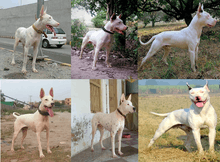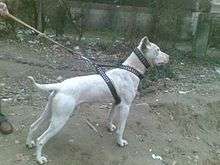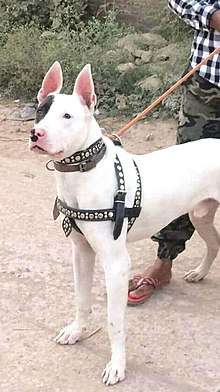Gull Terrier
The Gull Terrier (also known as the Gull Terr)[upper-alpha 1] is a rare breed of dog that originates from the Punjab region of Pakistan and India; it is believed to be several hundred years old.[1][2][4] They are often used in dog fighting, hunting, and guarding. The Gull Terrier is related to the Bull Terrier breeds that come from Great Britain.[2] These English dog breeds, along with those indigenous to the Indian subcontinent such as the Bully Kutta, played a major role in the Gull Terrier's breeding development and are considered to be a direct ancestor of the modern Gull Terrier.[2][5]
| Gull Terrier | |||||||||||||||||||||||||||||
|---|---|---|---|---|---|---|---|---|---|---|---|---|---|---|---|---|---|---|---|---|---|---|---|---|---|---|---|---|---|
.jpg)  | |||||||||||||||||||||||||||||
| Other names | |||||||||||||||||||||||||||||
| Origin | India[4] Pakistan[4] | ||||||||||||||||||||||||||||
| |||||||||||||||||||||||||||||
| Dog (domestic dog) | |||||||||||||||||||||||||||||
Origin

During the era of the British Raj in India, Bull Terriers were introduced to the northwest Indian subcontinent, which now includes the modern republics of India and Pakistan.[4] In colonial India, the Bull Terrier breed soared in popularity,[6] with the Bull Terrier Club of India being established in Calcutta.[7] Bull Terriers were crossed with local breeds to develop the Gull Terrier, often called the Indian Bull Terrier and also now the Indo-Pakistani Bull Terrier.[1][2][3] The Gull Terrier is a medium-sized dog with short, smooth fur which resembles that of the Staffordshire Bull Terrier.[2][4][8] These dogs were originally used in blood sports such as bull baiting, and dog fighting - a bloody entertainment introduced by the British to the Indian subcontinent.[9] When the blood sport was made illegal across the Empire, the Gull Terriers were used as guard dogs.[upper-alpha 2] In colonial India, some breeders crossed the Gull Terrier with the Bully Kutta, naming the progeny the "Gull Dong", which "is celebrated in India and Pakistan for its speed and tenacity".[11][12]
Personality

The Gull Terrier is guard dog that will be wary towards strangers. Their high aggression and strong drive to protect makes these dogs excellent protectors, guardians of people, and property. This is a dog breed known to offer their lives if need when defending their human family. Although, known to be aggressive with intruders and fierce because of their blood sports history, the Gull Terrier will be good with children in his immediate human family. These dogs should not be trusted with children that are not members of their family and pet animals that are non-canine. The Gull Terr is also famous for being very fast, very agile and nimble on his feet.
They are headstrong and a poor fit for interaction with children, even older children.[12]
Bred For

The Gull Terrier is India's and Pakistan's version of the English Bull Terrier dog breed.[2]
Environment
The Gull terrier was originally bred for Dogfights and guarding and Hence it is not a good Apartment dog. It requires daily exercise to meet its high energy.
Grooming
A Gull Terrier does not require a lot of attention, but does have some special needs when it comes to their grooming.
Training
Gull Terriers are very talented and easily trained.
Health
The Gull Terrier is prone to deafness and blindness,[13] but aside from that, there are no common medical problems affecting these dogs.
Many foreign Gull Terrier owners choose to fly to India for affordable treatment of medical conditions affecting their pets.[14][15]
Exercise
Gull Terriers are very energetic dogs, and demand exercise every day and should be taken on long walks.
Description
A Gull Terrier is a tall, broad chested, medium-sized molosser dog that is mostly found in Pakistan and India. Gull Terriers have large erect ears. Their coats are normally white, although sometimes they have dark colored markings on their faces and bodies.[4]
Temperament
Gull Terriers are wary of strangers. They are protective of their owners and territory. They are highly trainable .[4]
Ban
Under the New York City Housing Authority, Gull Terriers, alongside Gull Dongs, are banned in homes.[16][17] The dog is also banned in the Cayman Islands.[18]
Bibliography
- Semencic, Carl. The World of Fighting Dogs. City: Createspace Independent Publishing Platform. ISBN 1539606007.
References
Notes
- This breed is known by several names, including the South Asian Gull Terrier, South Asian Gull Terr, Indian Bull Terrier, Indo-Pakistani Bull Terrier, and Bull Terr.[1][2][3]
- Dating back to the British Indian Prevention of Cruelty to Animals Act, 1890, dog fighting is illegal and a violations of animal rights in Pakistan. "Unfortunately, funds to deal with animal rights in the department have dried up. Hence, the law that should prevent dog fights, camel fights, bear-baiting and the likes is violated all over Pakistan."[9] The Prevention of Cruelty to Animals Act (1960) in India "bars inciting or baiting animals into fighting. Receiving money or allowing any place to be used for such fights too is illegal."[10]
Citations
- "Pakistani bulldog". Radio Télé Africa. 2018. Retrieved 19 February 2019.
Gull Terr Appearance Body: the body of the Indian Gull Terrier is full and round, while the shoulders are robust and muscular and the tail is carried horizontally.
- Sicard, Gary (23 February 2003). "Indian Bullterrier". Molosser Dogs. Archived from the original on 25 November 2018. Retrieved 22 February 2019.
Many British officers brought their own fighting dogs and pitted them against each other and indigenous Indian dogs. Since old British bull-n-terrier breeds proved to be superiour fighters, many Indian and Pakistani breeders decided to improve their stock by crossing them with local Bully Kutta dogs. From these experiments a few distinct types were established, such as the Gull Terr, Gull Dong and others. The Indian Bull Terr was developed primarily from British dogs, namely Irish and English strains of the Staffordshire Bull Terrier, the original English White Terrier and the immensely popular Hinks Bullterrier breed.
- "Indian Gull Terr". La Provence Australe. Retrieved 22 February 2019.
- Singh Dhesi, Paramjeet. "Gull Terrier, Gull Terr, Kohati Gultair White Beauty and the Ancient Beast from the East". Creature Companion - A Pet care magazine. Archived from the original on 17 October 2018. Retrieved 17 October 2018.
The Gull Terr or Pakistani Bull Terrier is a rare breed of dog, which is found largely in Pakistan and in the Punjab region. ... They are typically found today in rural areas of Pakistan and in some parts of Indian Punjab.
- "Gull Terrier - Dog Breeds Guide - Pet Advisor". Petadvisor.com. Retrieved 25 November 2018.
- Copeman, George Henry; Rumble, Tony (1983). Capital as an Incentive. Jupiter Books. p. 115. ISBN 9780881689907.
The breed's popularity spread to India and Africa and to other countries of the Commonwealth, from whence it travelled to the United States and elsewhere.
- Hogarth, Thomas W. (2013). A Bull-Terrier Notebook. Read Books Ltd. ISBN 9781473385108.
- Kemmerer, Lisa (27 August 2015). Bear Necessities: Rescue, Rehabilitation, Sanctuary, and Advocacy. BRILL. ISBN 9789004293090. Retrieved 17 October 2018 – via Google Books.
- Hafeez, Zara. "The bloody world of dog fighting: Victory or death, there is no mercy!". The Express Tribune . Retrieved 17 October 2018.
- Kamal, Neel (16 June 2018). "Punjab puts a leash on illegal dog fights, files first case". The Times of India. Retrieved 26 February 2019.
- Sicard, Gary (23 February 2019). "Gull Dong". Molosser Dogs. Retrieved 25 February 2019.
- Anas, Muhammad (24 October 2018). "Gull Dong Dog Breed — The Loyal and Protector". Retrieved 25 February 2019.
- Sicard, Gary (23 February 2003). "Indian Bullterrier". Molosser Dogs. Archived from the original on 25 November 2018. Retrieved 22 February 2019.
- Goyal, Divya (9 February 2017). "NRIs prefer to come to India for cheap treatment of their pets". The Indian Express. Retrieved 21 February 2019.
- Singh, Harshraj (9 February 2017). "Vet tourism: Dog flown in from France, treated for Rs 10,000 in Punjab". Hindustan Times.
- "Working to End Dog Breed Ban in Public Housing". Thebark.com. Retrieved 22 November 2018.
- "Changes to NYCHA's Pet Policy" (PDF). New York City Housing Authority Journal. 39 (4). April 2009. Archived from the original (PDF) on 2012-01-11.
- Government of Canada, Canadian Food Inspection Agency (9 October 2015). "List of Dog Breeds Prohibited for Import into the Cayman Islands". Inspection.gc.ca. Retrieved 4 January 2019.